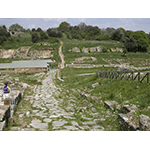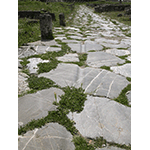Roselle Archaeological Area
Inhabited since the 7th century B.C. and definitively abandoned only in the 17th century, Roselle is one of the largest visitable archaeological areas in Tuscany.
From a technical-scientific viewpoint, the most interesting aspect lies in the massive Etruscan walls (built in the mid 6th century B.C. and reworked in later periods), the entire perimeter of which has survived and measures 3270 metres. Recent restoration has shed light on its technical features. The criteria followed in choosing the building materials (calcareous rock, sandstone and marl) were essentially based on the nearness of the sites of extraction to the worksites, as several still distinguishable quarries near the walls would seem to prove. Externally, the wall was built with a polygonal plan, with large irregularly shaped blocks laid onto the rock, specially levelled to guarantee stability. Its irregular profile was then evened with the addition of small nogs functioning as wedges. The internal facade was instead formed by smaller stones. Finally, the central part between the two faces was filled with a combination of earth and flaked rock, probably to assure good drainage.
Today’s visitor can take the footpath along the walls, which are especially visible on the northern side, where some of the structures have preserved up to five metres of their original height.
Again from the scientific viewpoint, the Roman remains too, offer interesting evidence of the technical knowledge of the ancients, especially in the fields of building and hydraulic engineering. One need only consider the large pool, more than two metres deep, of the baths dating to the age of Hadrian, on the slopes of the hill north of Roselle, or the monumental cistern in masonry dating to the imperial age, waterproofed with a layer of potsherd and still visible on the hill south. Also of great interest are the numerous, well-preserved segments of paved road which crossed town: of these, the cardo maximus still shows the ruts produced by the passage of carts, as opposed to the decumanus, which must have been used exclusively by pedestrians. Restoration performed in the past 20 years has exposed the differences of the road surface which ranges from a pavement formed by large river cobbles (via glareata) to a flagstone pavement made of large irregular polygonal blocks (via silicata) near the Roman forum, fitted into place and embedded in a cement preparation over a beaten earth bed.
****************************
Texts by Elena Fani
English translation by Victor Beard
Last update 09/feb/2008





